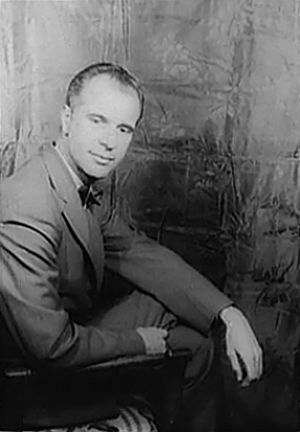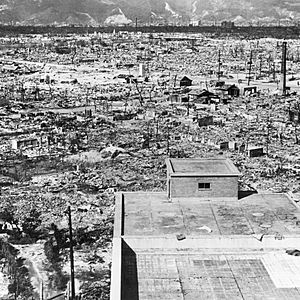John Hersey facts for kids
Quick facts for kids
John Hersey
|
|
|---|---|

John Hersey, 1958,
photographed by Carl Van Vechten |
|
| Born | John Richard Hersey June 17, 1914 Tientsin, China |
| Died | March 24, 1993 (aged 78) Key West, Florida, US |
| Occupation |
|
| Notable works | Hiroshima (1946) |
| Notable awards | Pulitzer Prize for "A Bell for Adano" |
| Spouses |
|
| Children | 5 |
John Richard Hersey (born June 17, 1914 – died March 24, 1993) was an American writer and journalist. He is known for using storytelling methods from fiction in his non-fiction writing. In 1999, his book Hiroshima, which described what happened after the atomic bomb was dropped on Hiroshima, Japan, was named the best piece of American journalism of the 20th century.
Contents
Early Life and Education
John Hersey was born in Tientsin, China. His parents, Grace Baird and Roscoe Hersey, were Protestant missionaries working for the YMCA. John learned to speak Chinese even before he learned English! Later, he wrote a novel called The Call (1985) based on his parents' lives.
When John was ten years old, his family moved back to the United States. He went to public school in Briarcliff Manor, New York. He even became the first Eagle Scout in his Boy Scout troop there. After high school, he studied at Yale University. He also played football at Yale.
Journalism and War Reporting
After college, Hersey worked for the author Sinclair Lewis for a summer. Then, in 1937, he started working for Time magazine. He later became a correspondent, reporting from different places.
During World War II, Hersey was a reporter covering the fighting in Europe and Asia. He wrote articles for Time and Life magazines. He went with Allied troops when they invaded Sicily. He even survived four airplane crashes! He was praised for helping to rescue injured soldiers from Guadalcanal. Before writing his famous book Hiroshima, he published a novel called Of Men and War. This book told war stories from the soldiers' point of view. One of his stories was inspired by future President John F. Kennedy, who was a brave naval officer during the war.
Reporting from Hiroshima
After the war, in late 1945, Hersey was in Japan reporting on how the country was being rebuilt. He found a document written by a Jesuit missionary who had survived the atomic bomb in Hiroshima. Hersey visited the missionary, who then introduced him to other survivors.
Hersey decided to write a long article for The New Yorker magazine about the bombing. He wanted to tell the story through the eyes of the people who lived through it. In May 1946, he went to Japan and spent three weeks interviewing survivors. He spoke to a German Jesuit priest, a widowed seamstress, two doctors, a minister, and a young factory worker.
The article he wrote was called "Hiroshima". It was 31,000 words long and was published in the August 31, 1946, issue of The New Yorker. The story focused on the atomic bomb dropped on Hiroshima on August 6, 1945, and how it affected these six survivors. The article was so important that it took up almost the entire magazine issue! This was something The New Yorker had never done before.
Later Books and Teaching
After writing Hiroshima, John Hersey mostly wrote fiction. His war novel The Wall (1950) was a bestseller. It was written like a journal and told the story of the Warsaw Ghetto. This was a place where Jewish people were forced to live by Nazi Germany during the Holocaust. The book won several awards.
In 1954, Hersey wrote an article called "Why Do Students Bog Down on First R?". This article was about how boring some school reading books were. It actually helped inspire Dr. Seuss to write his famous children's story, The Cat in the Hat! Hersey also wrote a novel called The Child Buyer (1960), which criticized the school system.
Hersey's first novel, A Bell for Adano, won the Pulitzer Prize in 1945. It was about the Allied forces taking over a town in Sicily during World War II. The book was even made into a movie that same year.
From 1965 to 1970, Hersey was the master of Pierson College at Yale University. This meant he was in charge of one of the university's residential colleges. He spoke out against the Vietnam War, which made some people disagree with him, but many students admired him. He also taught two writing courses at Yale for 18 years.
Hersey had a fun hobby: he ran a small printing press at the college. He even used it to print special posters. In 1969, he offered his bulldog, Oliver, to be the mascot for the Yale football team! He wondered if Oliver would stay awake for the games. With Oliver as the mascot, the Yale team had a good season.
In 1985, John Hersey went back to Hiroshima. He reported and wrote a follow-up article called Hiroshima: The Aftermath. The New Yorker published this update, and it was added to new editions of his book. Hersey wrote that "The memory of what happened at Hiroshima" is what has kept the world safe from atomic bombs since 1945.
Later Life and Death
John Hersey lived for a long time in Martha's Vineyard, Massachusetts. He died at his winter home in Key West, Florida, on March 24, 1993. He was buried near his home on Martha's Vineyard. He was survived by his second wife, Barbara Jean Day, his five children, and six grandchildren.
Honors and Legacy
John Hersey received many honors for his work. On October 5, 2007, the United States Postal Service announced that it would honor five journalists of the 20th century, including John Hersey, with special postage stamps. These stamps were released in 2008.
In 1968, John Hersey High School in Arlington Heights, Illinois was named after him.
Soon before Hersey's death, Yale University created the annual John Hersey Lecture to honor him. The first lecture was given in 1993. Yale also has the John Hersey Prize, which is given to students who show Hersey's spirit in their journalistic work. Many of his former students at Yale went on to become successful journalists and writers, including Michiko Kakutani and Jacob Weisberg.
Hersey held many important positions related to writing and education. He was the first person who wasn't a full-time professor to be named master of a Yale residential college. He was also president of the Authors League of America and was elected chancellor of the American Academy of Arts and Letters. He received honorary degrees from many universities.
Works
Hersey's books include:
- Men on Bataan, 1942
- Into the Valley, 1943
- A Bell for Adano, 1944
- Hiroshima, 1946
- The Wall, 1950
- The Marmot Drive, 1953
- A Single Pebble, 1956
- The War Lover, 1959
- The Child Buyer, 1960
- Here to Stay, 1963
- White Lotus, 1965
- Too Far To Walk, 1966
- Under the Eye of the Storm, 1967
- The Algiers Motel Incident, 1968
- Letter to the Alumni, 1970
- The Conspiracy, 1972
- My Petition for More Space, 1974
- The President, 1975
- The Walnut Door, 1977
- Aspects of the Presidency, 1980
- The Call, 1985
- Blues, 1987
- Life Sketches, 1989
- Fling and Other Stories, 1990
- Antonietta, 1991
- Key West Tales, 1994
See also
 In Spanish: John Hersey para niños
In Spanish: John Hersey para niños


